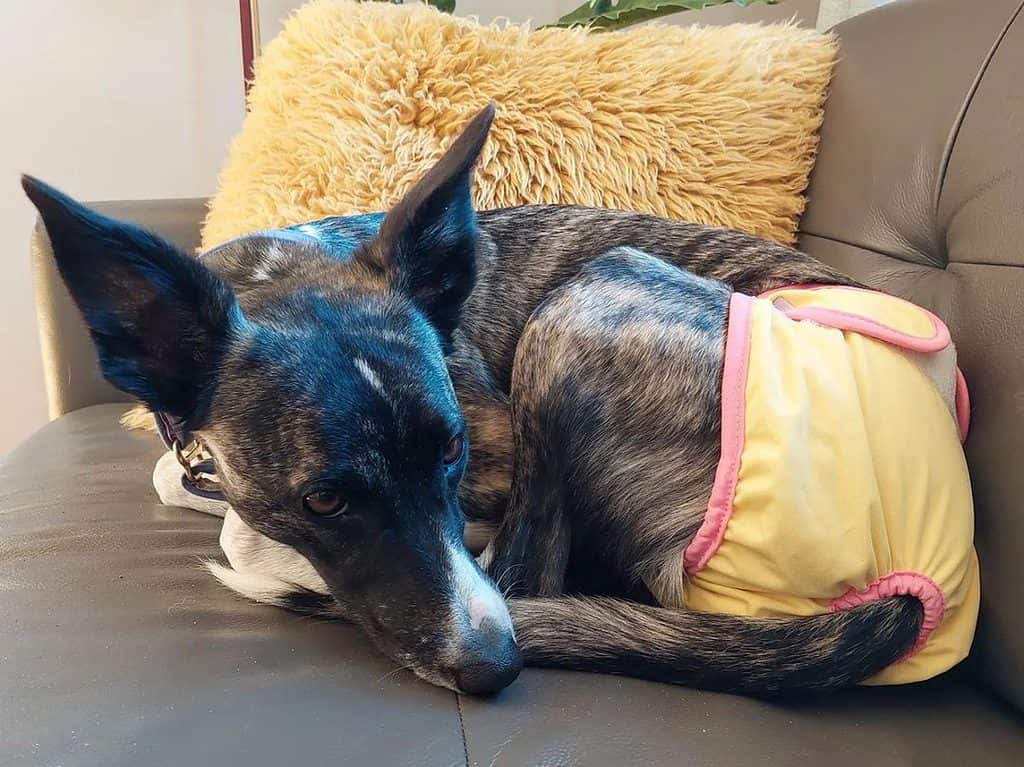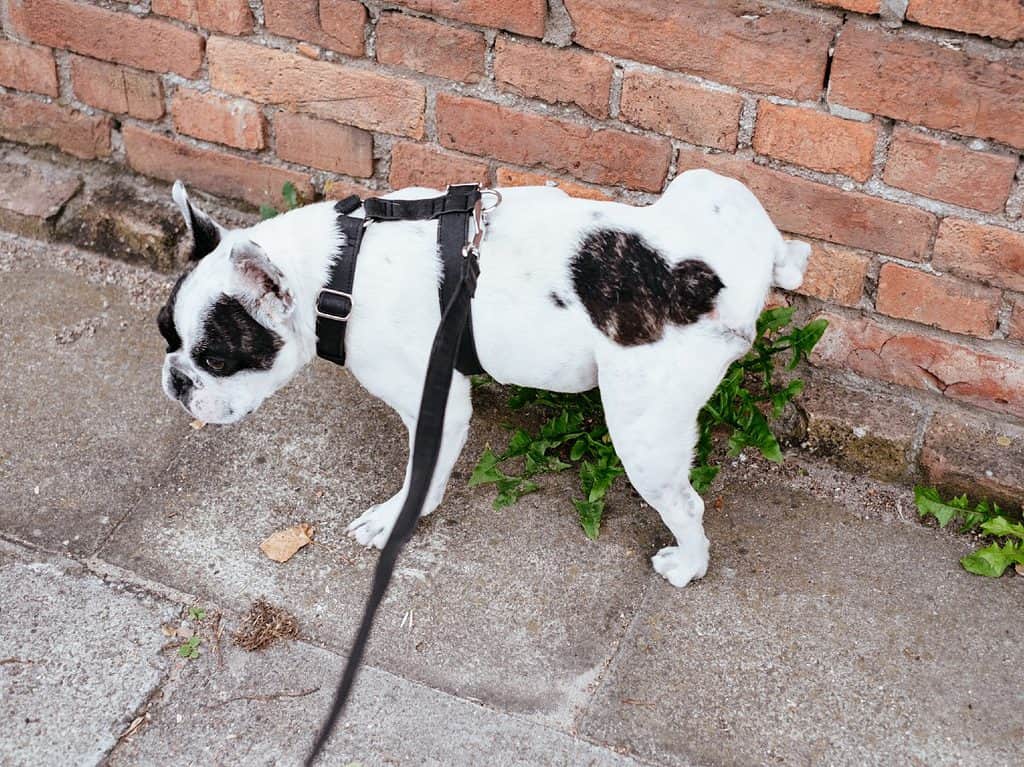Do you have a dog that just won’t stop turning your living room into its personal restroom? If this is an all-too-familiar issue in your household, you’re likely searching for answers on how to keep dogs from peeing on furniture.
Here’s all you have to do: read this comprehensive guide until the end!

Common Reasons For Dogs Peeing On Furniture
But first, figure out what’s causing your pup to pee on the furniture. Is it an old habit they’ve picked up? Perhaps they’re marking their territory or feeling anxious? Once you know why dear Max is misbehaving, you can start taking action to stop it.
Territorial Marking
Dogs are naturally territorial animals and may mark their boundaries by leaving behind small urine deposits. It lets other pets know who ‘owns’ particular home items, like the couches or beds.
Territorial marking is most common in male dogs, but females can engage in this behavior too, especially when feeling stressed or threatened by another animal in the home.
Anxiety
Dogs, like humans, experience anxiety and can express it through destructive behaviors, such as peeing in inappropriate places. And while furniture is a common target, understanding why your dog is anxious is key to adequately addressing the issue.
Dogs may become anxious when their humans leave them alone for prolonged periods. When they feel overwhelmed with anxiety, they may not know what else to do except urinate on the closest surface.
In addition, changes in routine can cause dogs to have bouts of nervousness or fear that manifest as inappropriate urination or marking behaviors on furniture and other surfaces within the house.
To counter your dog’s inappropriate urination, create an environment where your dog feels secure when left alone. Provide them with interactive toys to help keep them occupied when you are away from home.
We can’t say this enough — dogs love mental stimulation. They thrive with activities that challenge their minds and develop problem-solving skills.
Underlying Medical Conditions
Frequent urination may not be caused by misbehavior; your pup may have an underlying medical condition you don’t know about. For example:
Urinary Tract Infection (UTI): UTIs are caused when bacteria enter the urethra, the tube which carries urine from the bladder to outside the body, and multiply within the bladder. These infections can be painful for dogs, leading them to urinate more often or even in inappropriate places.
The first line of defense against a UTI is antibiotics. Your vet may prescribe your pup an oral or injectable antibiotic to treat the infection, depending on its severity.
Diabetes: Diabetes occurs when either the pancreas or liver doesn’t produce enough insulin, resulting in glucose not reaching cells for energy production. Diabetic dogs experience excessive thirst and frequent urination, often leading to an unfortunate accident on your furniture.
Treatments may involve dietary changes and insulin injections to help regulate glucose levels within a dog’s bloodstream. Regular weight and blood sugar monitoring are essential to adjust insulin dosages as needed.
Prostate Disease: Your male pup might have something more than just disobedience, causing him to pee on your furniture. Prostate disease, though not commonly known, can be one of the causes behind your pup’s accidents.
The symptoms of prostate disease in dogs vary depending on the stage of the condition. In its earliest stages, it may appear as though your dog has simply forgotten their potty training. He will frequently urinate throughout the day or night and may even urinate inside the house, especially on furniture.
Treatment options range from medications, such as antibiotics and anti-inflammatory drugs, to surgical procedures like prostatectomy.
Train your dog to pee in designated areas.

Training your pup to “go” in the right place is no small feat, but with patience, consistency and lots of positive reinforcement, it’s doable. Here are some tips for training your pooch to pee in the right spot.
Pick a designated area for him to go potty and stick with it. The potty area should be easily accessible and has plenty of room for him to move around. Put down puppy pads or newspaper if needed, anything encouraging them to use one spot consistently.
Next, praise your dog when he pees where he is supposed to. When he has finished his business, give him lots of treats as a reward; this will help reinforce the behavior you want from your dog going forward.
Crate your dog when you go away.
Going away often leaves pet owners with a problem: how to keep their beloved pup from getting into mischief while no one is home to supervise them. Crate training is an excellent way to solve this problem, as it offers safety and comfort for your four-legged family member.
As well as helping you avoid coming home to find your dog has chewed up the furniture, crate training can also help prevent them from peeing on furniture and other items in your house.
Get a suitable crate that is spacious enough for your dog to move around comfortably. Place blankets or towels inside that will make it cozy and inviting for her.
Whenever you leave the house, place treats inside the crate to motivate her to go there.
Giving your dog frequent bathroom breaks.
Give your dog plenty of access to the outdoors throughout the day. An easy way to do this is by setting up a designated area outside for potty breaks. Take your dog there at least every three hours and ensure he knows where to go when nature calls.
If possible, start taking him out after meals or playtime so his bladder will be empty when he comes back indoors.
Failing to give your dog frequent bathroom breaks can have major consequences. Not providing frequent potty breaks can impact your pooch’s behavior (like peeing on furniture) and overall health.
If you don’t give your dog enough time and opportunity for regular bathroom breaks, urine and feces can build up in your dog’s bladder and colon. This buildup increases the chances for bacterial infections, which may cause pain and discomfort and lead to kidney or liver damage if untreated.
Additionally, the buildup of waste can also lead to painful urinary tract infections for pets, which are expensive for owners to treat.
Spay or neuter your dog.
One of the biggest benefits of spaying and neutering your dog is that it can help keep them from having accidents in the house. This procedure helps reduce their urge to roam around looking for a mate, preventing them from marking their territory by peeing on furniture and other items in the home.
Not only can this save you some serious cleaning time, but it also helps keep stress levels low for you and your pup.
But who is best qualified to do these procedures?
Veterinarians are always the best option for spaying or neutering your furry friend. They have extensive experience performing these procedures safely and effectively and stay up-to-date on the latest veterinary research and techniques.
Use doggy diapers.
Do you want to know how to keep dogs from peeing on furniture in the most effortless way? Invest in dog diapers!
Dog diapers come in a variety of sizes and styles. You can choose disposable or reusable options depending on what fits best for you and your pup’s needs.
Reusable versions are made with soft materials like cotton, providing maximum comfort for your pup while protecting furniture from accidents. Disposable diapers are less time-consuming when cleaning up; all you have to do is dispose of them after use.
But remember this: male and female dogs have different needs regarding the type of diaper best for them. Diapers specifically designed to fit around the penis are available in several shapes and sizes for male dogs. They are great for containing messes while still allowing your pup some freedom of movement.
Female dogs may require more coverage than a simple wrap-around diaper can provide; they usually need full-coverage panties with an absorbent liner built into the design.
Clean the area your dog has marked thoroughly.
We can all agree that the smell of dog urine is unmistakable. It’s an unpleasant experience and can be hard to get rid of.
Experienced pet owners recommend using an enzymatic cleaner, which breaks down the odor-causing bacteria in their pee, so it doesn’t attract future urination.
Additionally, dogs hate to pee on spots that smell like vinegar, citrus, and rubbing alcohol.
Dogs dislike peeing on spots with a strong vinegar scent.
From white vinegar to apple cider vinegar, any type of this sour-smelling liquid will do the trick to keep dogs away from your couch.
The secret lies in vinegar’s acidic properties, which are harsh enough that many animals find them off-putting. Dogs have an especially sensitive sense of smell, making it difficult for them not to mind the common kitchen ingredient’s sour, pungent odor.
Dogs dislike peeing on spots with a citrus scent.
One tactic that many have found successful is using citrus scents to deter dogs from peeing on furniture. Citrus has long been used as a natural repellent for animals, and its strong odors can effectively discourage dogs from marking their territory on couches and chairs.
This technique is relatively simple and inexpensive; place slices of lemon or orange peels, or spray a solution of water mixed with lemon juice around your furniture.
Dogs dislike peeing on spots with a rubbing alcohol scent.
If you’re tired of constantly cleaning up after your pup’s mess, it’s time to take action and learn how to keep dogs from peeing on furniture. One way to do this is by introducing a scent that dogs dislike — rubbing alcohol. Rubbing alcohol has a strong odor that dogs find unpleasant, so they tend to stay away when it’s present.
Simply spray your furniture with rubbing alcohol, making your dog turn away and choose another area for his business. This method has been known to work with most breeds, so give it a try if yours isn’t getting the message about proper bathroom etiquette.
What You Should Not Do
Do not punish your dog if they pee on your furniture. While it is natural to feel angry and frustrated, punishing your pup for this behavior is never the answer. Doing so can cause more problems than it solves and may result in a scared or anxious dog that still doesn’t understand why they are being punished.
The best way to keep your dog from peeing on your furniture is by:
- ruling our underlying medical conditions;
- training your dog to pee in designated areas;
- crating your dog when you go away;
- giving your dog frequent bathroom breaks;
- spaying or neutering your dog;
- using dog diapers; and
- cleaning the area that your dog has peed on.
With these simple tips, you can ensure that your furniture remains urine-free going forward.
References
Sherman, B. L. (2008). Separation anxiety in dogs. Compendium, 30(1), 27-42.
Overall, K. L., Hamilton, S. P., & Chang, M. L. (2006). Understanding the genetic basis of canine anxiety: phenotyping dogs for behavioral, neurochemical, and genetic assessment. Journal of Veterinary Behavior, 1(3), 124-141.
Bartges, J. W. (2004). Diagnosis of urinary tract infections. Veterinary Clinics: Small Animal Practice, 34(4), 923-933.




